by Maureen Buja, Interlude

Barry Manilow © Ticketmaster
We know…there’s only 12 notes in a scale and how many different ways can there be of combining them? Sometimes, you get a song in your ear and start to hear it in many different places. Sometimes it was deliberate on the part of the modern composer. If we look at Barry Manilow’s 1971 song and 1975 hit Could It Be Magic we can hear immediately that there’s something classical on the loose! The story is that Manilow was playing around with a melody that he’d been playing at home – a little piano prelude by Chopin – and by elaborating on the melody, came up with his own song. By adding his quotation of the Chopin original at the beginning and end of his song, he framed his own reading of the work beautifully.
Jean-Paul-Égide Martini’s vocal romance Plaisir d’amour, written in 1783, is a bittersweet song about a disappointed lover: ‘I left everything for…Sylvie, she left me for another lover’ with the constant refrain of ‘Love’s pleasure last but a moment, Love’s disappointment lasts a lifetime.’ It is a standard for the classical singer.
In the hands of songwriters Hugo Peretti, Luigi Creatore, and George David Weiss, however, the song became an affirmation of love: ‘Darlin, so it goes, Some things were meant to be.’ Our lover is swept along, unable to help giving not only his hand but his ‘whole life, too’ to his beloved.
Another Elvis hit based on a song from earlier times was his 1960 No. 1 hit It’s Now or Never. Before it was a pop favourite, however, it was a song written in 1898 in the Neapolitan dialect celebrating not only the beauty of the sun but the beauty of his love’s face. Eduardo di Capua’s song, developed from a set of melodies he had purchased from Alfred Mazzucchi, is traditionally sung in Neapolitan rather than standard Italian (where the title would be Il mio sole). Luciano Pavarotti’s performance of the song won the 1980 Grammy Award for Best Classical Vocal Performance.

© 45cat
In 1949, new lyrics were given to it as ‘There’s no tomorrow’ and it was a hit for Tony Martin. Elvis heard the song in Germany and made a private recording and when he was back in the States, requested new lyrics for it. He also heard the Mario Lanza recording of the original while he was in Germany. Aaron Schroeder and Wally Gold came up with ‘It’s Now or Never.’ Now there’s a sense of urgency – ‘tomorrow will be too late’ for his ‘love won’t wait.’ The song became one of Elvis’ best-selling singles, with over 20 million copies. The song was No. 1 on the charts in the US, the UK, Australia, Canada, Belgium, Ireland, The Netherlands, New Zealand, Norway, and South Africa; it only got to No. 2 in Germany. In concert, Elvis always acknowledged the origin of the song, speaking about its origin and having a singer perform a brief part of the original.
The Russian composer Alexander Borodin proved to be inspirational for the 1950s. The 1911 play Kismet by Edward Knoblock was adapted by Charles Lederer and Luther Davis and had lyrics and music adapted and created by Robert Wright and George Forrest. The whole project had been commissioned by Edwin Lester of the Los Angeles Civic Light Opera. The music they adapted came from 9 different works by Borodin, including 4 different pieces from his opera Prince Igor. Borodin’s String Quartet No. 2 in D major was the source for the song ‘Baubles, Bangles, and Beads’.
‘Baubles, Bangles and Beads’ occurs in the scene with our heroine Marsinah in the marketplace, where she’s seen by the young Calif. The Calif later, in the guise of a gardener, sings Stranger in Paradise (based on the ‘Polovtsian Dances’ from Prince Igor) when he sees her. In 1954, the musical won three Tony Awards for Best Music, Best Performance by a Leading Actor in a Musical, and Best Conductor and Musical Director.
What could possibly connect Bruckner’s Fifth Symphony with a song that was voted one of the best songs of the first decade of the 21st century and has become a sports anthem? Well, if we take the theme used in first and fourth movements (at 02:29 and 00:46), we have the fundamentals of the guitar riff of Jack White’s Seven Nation Army.
White came up with the guitar riff while on tour in Melbourne in 2002. It then developed further as ‘a little experiment’ where White tried to create a song that was compelling but that didn’t have chorus. The title, a mishearing of ‘Salvation Army’ as ‘Seven Nation Army’, was first used as a placeholder name and then it stuck.
Muzio Clementi‘s Sonatina, Opus 36, No. 5’s third movement Rondo was the basis for a chart-topper recorded by The Mindbenders in 1965 and later by Phil Collins in 1988.
A Groovy Kind of Love had been written by Tony Wine and Carole Bayer Sager as a play on the new word that had come to popularity in the mid-1960s, ‘groovy’. It was the happening word of the day and once they came up with the hook of ‘a groovy kind of love’ they say the song wrote itself in about 20 minutes.
The Mindbender’s 1965 version was nowhere close in speed to the Clementi original, but Phil Collins’ 1988 version slowed the tempo to a ballad and it reached No. 1 on the UK and US charts.
We think of Rachmaninoff’s piano works as full of grand gestures, great voiced chords that move from one end of the piano to the other. Yet, he was also a composer of delicate, sweet melodies, as was discovered by Eric Carmen.
His 1975 song All By Myself made No. 1 in the US and Canadian charts. Carmen’s use of the theme from the second movement of Rachmaninoff’s Piano Concerto No. 2 was deliberate, and, unfortunately, was also still in copyright. Rachmaninoff’s work was out of copyright in the US but was still protected outside the US and he had to pay royalties to the Rachmaninoff estate for his use of the melody.
We saw this composer’s effect on Barry Manilow, but if we look back a century ago, another work by Frédéric Chopin was also a pop hit. His Fantaisie-Impromptu of 1834 was published in 1855 after Chopin’s death, despite his explicit instructions that none of his unpublished works be brought out. Chopin guessed wrong as his Fantaisie-Impromptu has become one of his most frequently performed works.
This work inspired vaudeville composer Harry Carroll to write I’m Always Chasing Rainbows in 1917, which was used in the Broadway show Oh Look! in 1918 and in Hollywood films in 1941 and 1944. In 1973, it was added into the revival of the 1919 musical Irene. There was also a revival of the song in 1946, where it was a hit for singers such as Perry Como, and the duo of Helen Forrest and Dick Haymes.
From Broadway to Hollywood and to the Top 10 in Pop Music – there’s always a place for classical music!
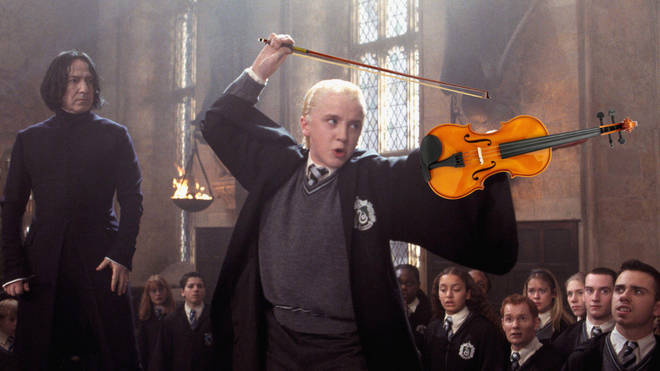



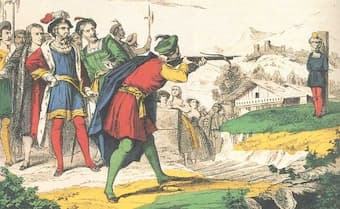
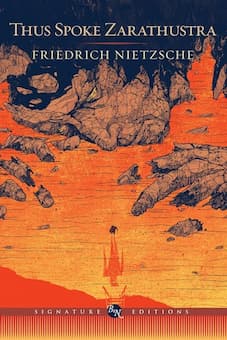

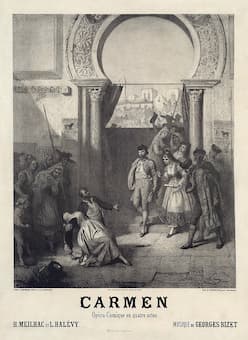

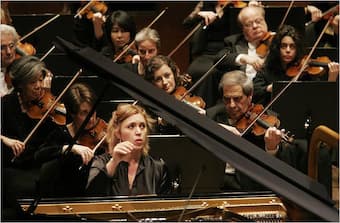 The Argentinian pianist Lyl Tiempo started Montero on formal piano lessons at the age of four, and she gave her first public performance at the age of five. She made her public debut at the age of eight, performing the Haydn D Major concerto with the National Youth Orchestra of Venezuela, conducted by José Antonio Abreu. Montero writes, “I did all the competitions and had a lot of success with that. I have always performed, but for me it’s been an ongoing ambivalent kind of question, because it’s not just who you are and what you were born to do, but what you choose to dedicate your life to and the sacrifices that come with that.” At the age of 9, Montero received a scholarship from the Venezuelan government to study in the US, and from 1990 until 1993, she studied at the Royal Academy of Music in London with
The Argentinian pianist Lyl Tiempo started Montero on formal piano lessons at the age of four, and she gave her first public performance at the age of five. She made her public debut at the age of eight, performing the Haydn D Major concerto with the National Youth Orchestra of Venezuela, conducted by José Antonio Abreu. Montero writes, “I did all the competitions and had a lot of success with that. I have always performed, but for me it’s been an ongoing ambivalent kind of question, because it’s not just who you are and what you were born to do, but what you choose to dedicate your life to and the sacrifices that come with that.” At the age of 9, Montero received a scholarship from the Venezuelan government to study in the US, and from 1990 until 1993, she studied at the Royal Academy of Music in London with  Following into the footsteps of
Following into the footsteps of 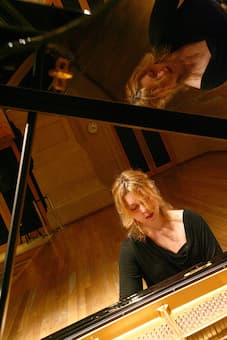 Montero has appeared with many of the world’s leading orchestras, and she is a highly sought-after recitalist. However, Montero has also turned to composition and won a Grammy for Best Classical Album at the 2015 Latin Grammy Awards. She focused exclusively on works by Latin American composer, as “more and more there seems to be a real want for this kind of migration of cultures and sounds and composing. I found that with my own concerto, the Latin Concerto, which I play a lot, there’s an incredible openness to classical music language with other rhythms, harmonies, and influences. More and more, we see programming that combines this kind of repertoire and people find the connection between the styles. I see more diversity in programming, which is good.” However, Montero’s work is not limited to musical stages, as she is a committed human rights advocate. Amnesty International named her Honorary Consul in 2015, and the Human Rights Foundation honored her with the Outstanding Work in the Field of Human Rights award for her ongoing commitment to human rights advocacy in Venezuela. She has been outspoken in her support for those who have challenged the current Venezuelan regime, and has deplored the state of the country and the crackdown on protesters. The advice she gives to young professionals and students is straightforward, “There are no guarantees, nor formulas… What keeps you grounded is always just thinking about the music and wanting to be a better artist… Never lose sight of the higher goals, which are really to become a better communicator and a better person through it. Also, realize that you have power as an artist to speak, to get involved. Be informed. Speak for the right people. Speak on behalf of people! Use your music for more than just entertainment!”
Montero has appeared with many of the world’s leading orchestras, and she is a highly sought-after recitalist. However, Montero has also turned to composition and won a Grammy for Best Classical Album at the 2015 Latin Grammy Awards. She focused exclusively on works by Latin American composer, as “more and more there seems to be a real want for this kind of migration of cultures and sounds and composing. I found that with my own concerto, the Latin Concerto, which I play a lot, there’s an incredible openness to classical music language with other rhythms, harmonies, and influences. More and more, we see programming that combines this kind of repertoire and people find the connection between the styles. I see more diversity in programming, which is good.” However, Montero’s work is not limited to musical stages, as she is a committed human rights advocate. Amnesty International named her Honorary Consul in 2015, and the Human Rights Foundation honored her with the Outstanding Work in the Field of Human Rights award for her ongoing commitment to human rights advocacy in Venezuela. She has been outspoken in her support for those who have challenged the current Venezuelan regime, and has deplored the state of the country and the crackdown on protesters. The advice she gives to young professionals and students is straightforward, “There are no guarantees, nor formulas… What keeps you grounded is always just thinking about the music and wanting to be a better artist… Never lose sight of the higher goals, which are really to become a better communicator and a better person through it. Also, realize that you have power as an artist to speak, to get involved. Be informed. Speak for the right people. Speak on behalf of people! Use your music for more than just entertainment!”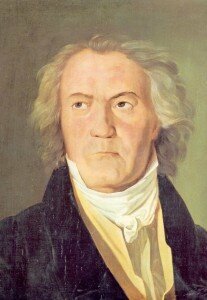



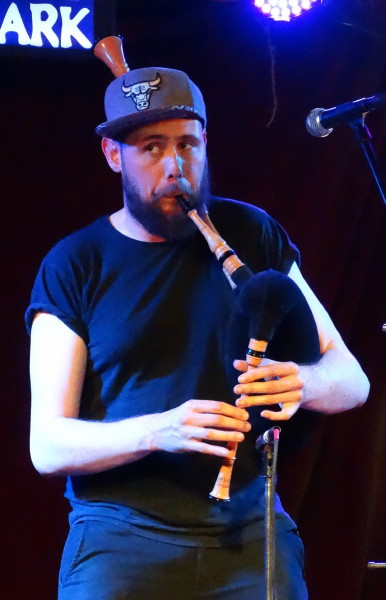
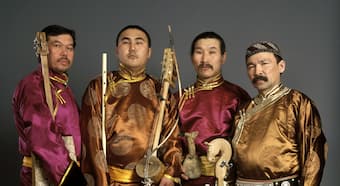
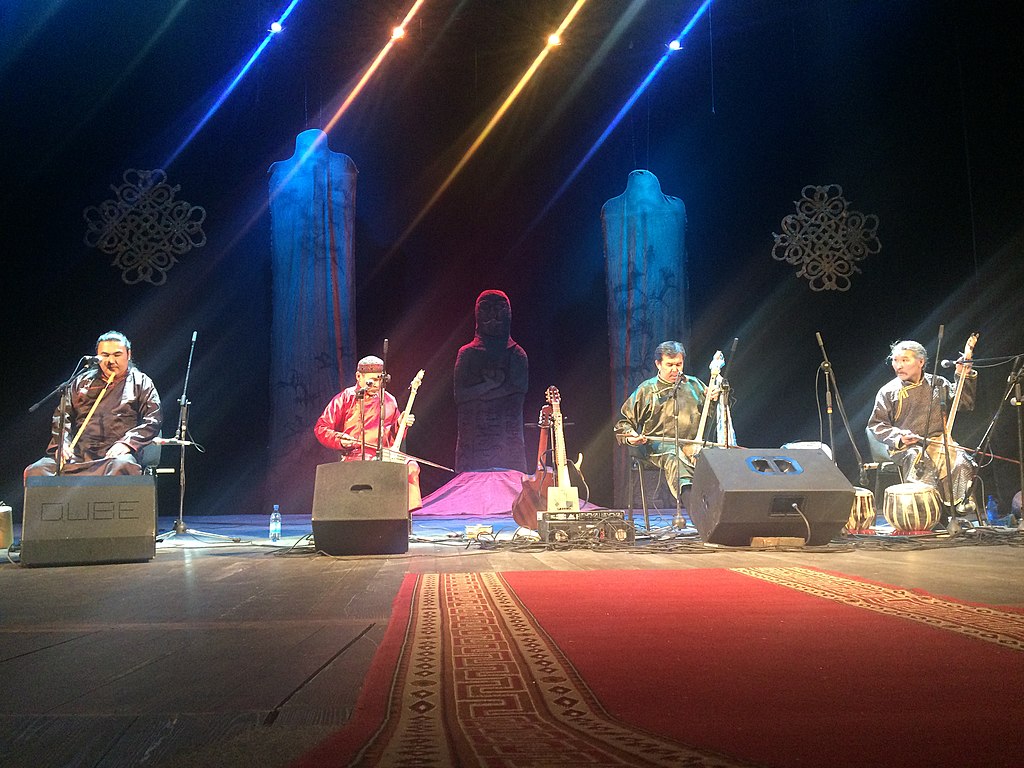 The animistic worldview of this region identifies the spirituality of objects in nature, not just in their shape or location, but in their sound as well. As such, the human mimicry of nature’s sounds is considered the root of throat singing, and cultures in this part of Asia have developed many instruments and techniques to mimic the sounds of animals, wind and water. Tuvan throat singing is traditionally sung by a soloist, or a group of soloist, and accompanied by a percussion section imitating the sound of horse hooves. Many groups also use traditional Tuvan instruments, including a bowed instrument called the “igil,” and a Jaw-harp called a “khomus,” among various other unique string instruments. Throat singing was once only a folk tradition, but it is now embraced as an emblem of Tuvan identity and more often performed by professionals in formal settings.
The animistic worldview of this region identifies the spirituality of objects in nature, not just in their shape or location, but in their sound as well. As such, the human mimicry of nature’s sounds is considered the root of throat singing, and cultures in this part of Asia have developed many instruments and techniques to mimic the sounds of animals, wind and water. Tuvan throat singing is traditionally sung by a soloist, or a group of soloist, and accompanied by a percussion section imitating the sound of horse hooves. Many groups also use traditional Tuvan instruments, including a bowed instrument called the “igil,” and a Jaw-harp called a “khomus,” among various other unique string instruments. Throat singing was once only a folk tradition, but it is now embraced as an emblem of Tuvan identity and more often performed by professionals in formal settings. 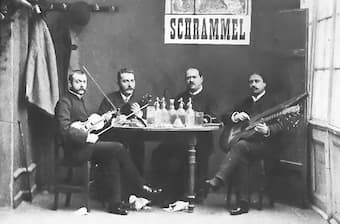
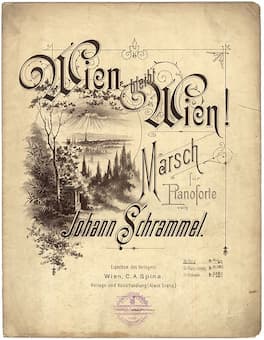
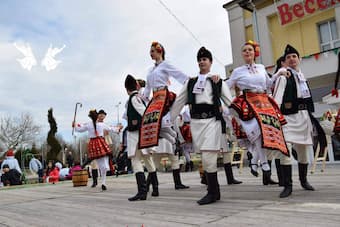
 Bulgarian folk music is known for its asymmetrical rhythms, where the meter is split into uneven combinations of short and long metric beats. In essence, they correspond to the short and long steps during dancing. Each basic folk dance type uses a distinct combination of these rhythmic units. The “Rachenisa” features seven beats divided 2+2+3, the “Paydushko Horo” features five beats organised 2+3, the “Eleno Mome” has seven beats divided 2+2+1+2, and the very complicated “Bucimis” subdivides its 15 beats as 2+2+2+2+3+2+2). Bulgaria experienced some seriously tumultuous political times during the middle of the 20th century. “The political events of 1944 resulted in the institutionalization of all musical activities within a monolithic network of state administrative organs whose representative bureaus extended into every city, town, and village, and whose structure and ideals emulated those of Soviet cultural development.” A substantial number of professional folksong and dance ensembles started to emerge, with the objective to preserve the performance of village music in a contemporary format representative of the socialist state. The ensemble “Chinary” was founded after the fall of the iron curtain, and includes professional dance artists, musicians and singers. The repertoire of the ensemble includes dance and song traditions of all folklore regions of Bulgaria. “The performances of Chinari are unique in terms of modern staging on production of traditional Bulgarian folklore, and offer an incredibly successful combination of talent, beauty, youth and professionalism.”
Bulgarian folk music is known for its asymmetrical rhythms, where the meter is split into uneven combinations of short and long metric beats. In essence, they correspond to the short and long steps during dancing. Each basic folk dance type uses a distinct combination of these rhythmic units. The “Rachenisa” features seven beats divided 2+2+3, the “Paydushko Horo” features five beats organised 2+3, the “Eleno Mome” has seven beats divided 2+2+1+2, and the very complicated “Bucimis” subdivides its 15 beats as 2+2+2+2+3+2+2). Bulgaria experienced some seriously tumultuous political times during the middle of the 20th century. “The political events of 1944 resulted in the institutionalization of all musical activities within a monolithic network of state administrative organs whose representative bureaus extended into every city, town, and village, and whose structure and ideals emulated those of Soviet cultural development.” A substantial number of professional folksong and dance ensembles started to emerge, with the objective to preserve the performance of village music in a contemporary format representative of the socialist state. The ensemble “Chinary” was founded after the fall of the iron curtain, and includes professional dance artists, musicians and singers. The repertoire of the ensemble includes dance and song traditions of all folklore regions of Bulgaria. “The performances of Chinari are unique in terms of modern staging on production of traditional Bulgarian folklore, and offer an incredibly successful combination of talent, beauty, youth and professionalism.”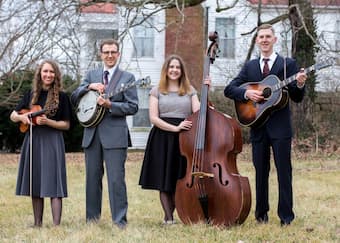
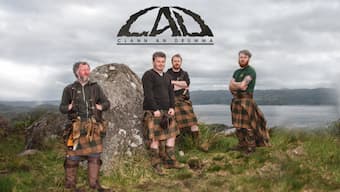
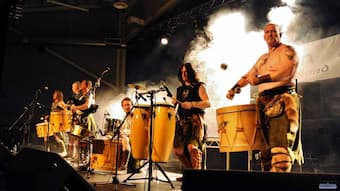 Of course, the bagpipe is usually associated with Scottish folk music, but the origins of that instrument if found throughout large areas of Europe, North Africa, and South Asia. The earliest mention of bagpipes in Scotland dates to the 15th century although they are believed to have been introduced to Britain by the Roman armies. The pìob mhór, or Great Highland Bagpipe, was originally associated with both hereditary piping families and professional pipers to various clan chiefs; later, pipes were adopted for use in other venues, including military marching. But wait, “Clann an Drumma” isn’t your traditional bagpipe music. Of course, the tunes are mostly traditional pieces carried by the pipes, but when the percussion kicks in it turns into a thunderous new world. And when the four tattooed drummers add vocalizations, which is often wordless, sometimes shouting, it becomes music that you can actually feel pulsing through your body. If nothing else, it will get your heart racing and your foot tapping.
Of course, the bagpipe is usually associated with Scottish folk music, but the origins of that instrument if found throughout large areas of Europe, North Africa, and South Asia. The earliest mention of bagpipes in Scotland dates to the 15th century although they are believed to have been introduced to Britain by the Roman armies. The pìob mhór, or Great Highland Bagpipe, was originally associated with both hereditary piping families and professional pipers to various clan chiefs; later, pipes were adopted for use in other venues, including military marching. But wait, “Clann an Drumma” isn’t your traditional bagpipe music. Of course, the tunes are mostly traditional pieces carried by the pipes, but when the percussion kicks in it turns into a thunderous new world. And when the four tattooed drummers add vocalizations, which is often wordless, sometimes shouting, it becomes music that you can actually feel pulsing through your body. If nothing else, it will get your heart racing and your foot tapping.